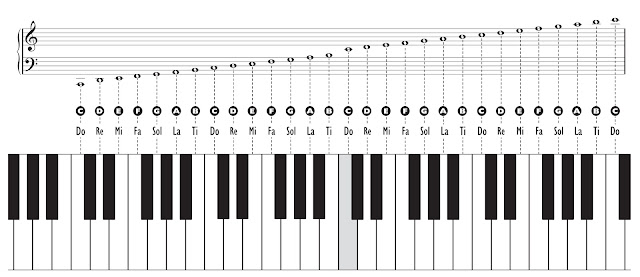Notes on the Grand Staff
If you’re like the majority of the parents at Jensen’s Yamaha, you have not ever taken any formal music lessons. This can make class challenging sometimes, but don’t worry – we’re here to help!
Let’s first just look at a keyboard or piano to understand how the notes are organized.
The low notes on a piano are on the left side (think Ls for left and low). High notes are on the right side.
 |
| <---------------------------------------------Low notes Middle DO (C) High notes -----------------------------> |
Now if you look at this chart, you can see how the notes on the piano relate to the grand staff. The grand staff is when you have two staves that are joined together – this is where most piano music is notated. It is easy to see how the notes are moving up the grand staff as the notes get higher. Also notice that middle DO is in the middle of the keyboard as well as the middle of the grand staff!
- staff (pl. staves) : a set of 5 horizontal lines and 4 spaces that each represent a different musical pitch
- grand staff : when you have two staves that are joined together
When we start in JMC Book 1, the first songs look something like this (read from left to right):
Recognize the song? Yes, it’s “Hot Cross Buns”! The first repertoire piece in JMC Book 1. Notice that there is only one staff (that’s what we call the 5 lines) and a G clef (or treble clef). We use the G clef because we are playing the notes above middle DO (or middle C).
By the end of JMC Book 1 and the beginning of book 2, we start to use our left hand (LH) as well. Here’s what changes :
- The songs are notated on the grand staff.
- The top staff is always for the right hand (RH), the bottom staff is for the LH.
- Most beginner songs will have the G clef (or treble clef) in the top staff and the F clef in the lower staff. This is because most of the notes played by the RH will be the notes above middle DO (C) and most of the notes played by the LH will be below middle DO (C).
When you have a grand staff, you still read from left to right, but now both hands can play at the same time. At the beginning of this song, you’ll notice that there are notes for the RH to play, but if you look directly below in the F clef, there is only a rest. The LH does not play at the beginning.
Don’t worry about why right now, but just know that there are bar lines that divide up the staves into equal parts. In the example above, the bar lines are blue. We call these equal parts bars or measures.
The LH has it’s first note in the third measure. It lines up with the note RE in the RH – that means you play them at the same time!
So there you go! Please let me know if you have any questions or if this is too much information!
You can also check out this website http://www.musictheory.net/. They have animated music theory lessons, however, they will be using the letters instead of solfege (but you can use the chart above!!)




Leave a Reply